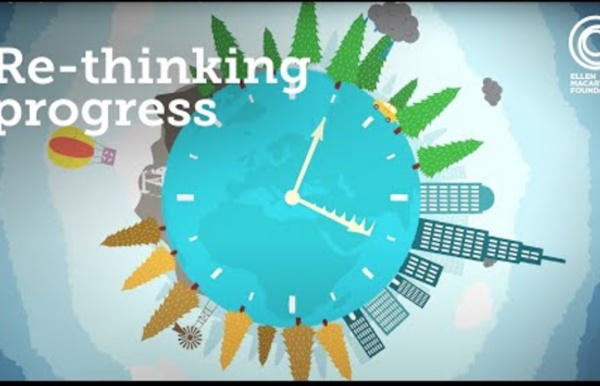



http://www.youtube.com/watch?v=zCRKvDyyHmI
Related: HISTORIA Y TEORIA DEL DISEÑO IND. INTERACCIÓN • ÉCO CONCEPTIONTop 20 Greatest Inventions of All Time Technology is a core component of the human experience. We have been creating tools to help us tame the physical world since the early days of our species. Any attempt to count down the most important technological inventions is certainly debatable, but here are some major advancements that should probably be on any such list (in chronological order): 1. Efficiency vs Effectiveness A key difference Eco-efficiency begins with the assumption of a one-way, linear flow of materials through industrial systems: raw materials are extracted from the environment, transformed into products, and eventually disposed of. In this system, eco- efficient techniques seek only to minimise the volume, velocity, and toxicity of the material flow system, but are incapable of altering its linear progression. Some materials are recycled, but often as an end-of-pipe solution, since these materials are not designed to be recycled. Instead of true recycling, this process is actually downcycling, a downgrade in material quality, which limits usability and maintains the linear, cradle-to-grave dynamic of the material flow system.
Indian man single-handedly plants a 1,360-acre forest A little more than 30 years ago, a teenager named Jadav "Molai" Payeng began burying seeds along a barren sandbar near his birthplace in northern India's Assam region to grow a refuge for wildlife. Not long after, he decided to dedicate his life to this endeavor, so he moved to the site so he could work full-time creating a lush new forest ecosystem. Incredibly, the spot today hosts a sprawling 1,360 acres of jungle that Payeng planted — single-handedly. The Times of India recently caught up with Payeng in his remote forest lodge to learn more about how he came to leave such an indelible mark on the landscape.
Rethinking the Economy Circular Economy Overview Looking beyond the current take-make-dispose extractive industrial model, a circular economy aims to redefine growth, focusing on positive society-wide benefits. It entails gradual... Read more Circular Economy System Diagram What Apple, Google, And Tesla Get Wrong Don Norman is a technological optimist. The author of The Design of Everyday Things and head of UC San Diego's Design Lab believes that artificial intelligence might only take the worst parts of our jobs, and when it gets smart enough, it will pity us rather than destroy humanity. On these points, the scientist in him admits that he might be wrong, but Norman would prefer to live his life hoping for the best. Because nobody wants to go to sleep at night expecting a Terminator in his bed in the morning. But that doesn’t mean Norman isn’t critical of the direction of Silicon Valley’s powerhouse companies often celebrated for merging technology and design.
Ecodesign Guide - Ecodesign research and implementation at DTU DTU Management Engineering, IPU, the Danish Environmental Protection Agency and the Confederation of Danish Industry have developed a practical Guide to integration of environmental thinking into product development. Based on a detailed study of methods and experiences with environmentally conscious product development in Danish and international companies, and through a series of in-depth workshops with industrial companies in Denmark, a Guide to environmental improvement through product development has just been published. The Guide is primarily aimed at product developers, as a help to the integration of environmental thinking into the development process, and therefore into products.
A New Dawn 13th Jun 2013; 13:00 Listen to the audio (full recording including audience Q&A) Please right-click link and choose "Save Link As..." to download audio file onto your computer. Video: Watch Rachel Botsman's talk from Wired 2011 spaceplay / pause escstop ffullscreen shift + ←→slower / faster (latest Chrome and Safari) ←→seek Shh! Don’t Tell Them There’s No Magic In Design Thinking When the term Design Thinking first emerged on the scene, I found it completely puzzling. People were treating it as if it was a revolutionary new methodology to produce better products and services. They were talking about how entire companies were adopting this new approach, and those companies were becoming more competitive in the marketplace and seeing huge increases in customer satisfaction.
OverviewSentinel Mission The spacecraft and instrument use high-heritage flight proven deep space systems, originally developed by NASA, to minimize technical and programmatic risks. These heritage missions include large space-based telescopes (Spitzer, Kepler), a large format camera made up of many individual detectors (Kepler), and a cryogenically cooled instrument (Spitzer). By detective and tracking nearly all of the Near Earth Objects greater than 50 meters in diameter, the Sentinel Space Telescope will create a map of the solar system in Earth’s neighborhood enabling future robotic and manned exploration.
Design - Phase - Close The Loop Digging through the discards of other people’s closets, we seldom find clothes that are completely worn out -- rather, we usually come across pieces that are still perfectly usable. We could argue that products have two potential expiry dates: the first when they break or fall apart, the second when their owner is simply tired of them. This brings us to the question: how can we integrate emotional aspects into our products to make sure our feelings for them last?
ARBOBLEND® ARBOFILL® ARBOFORM® So that it is easier for you to find your way around when selecting materials, the TECNARO portfolio with more than 3,500 formulas has been divided into three material groups: ARBOBLEND® combines a great number of material types and a wide range of property profiles. The materials on offer are up to 100% bio-based. Depending on the formula, ARBOBLEND® materials contain biopolymers such as polyhydroxyalkanoates (PHA), polycaprolactone (PCL), polyester (e.g. bio-PET), starch, polylactic acid (PLA), bio-polyolefins (bio-PE), bio-polyamides (bio-PA), lignin, natural resins, natural waxes, natural oils, natural fatty acids, cellulose, organic additives and natural reinforcing fibres.